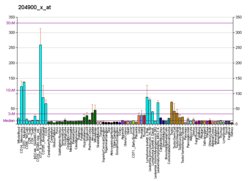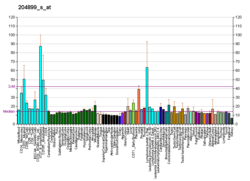SAP30
Sin3A-associated protein, 30kDa, also known as SAP30, is a protein which in humans is encoded by the SAP30 gene.[5]
Function
Histone acetylation plays a key role in the regulation of eukaryotic gene expression. Histone acetylation and deacetylation are catalyzed by multisubunit complexes. The protein encoded by this gene is a component of the histone deacetylase complex, which includes SIN3A, SAP18, HDAC1, HDAC2, RbAp46, RbAp48, and other polypeptides. This complex is active in deacetylating core histone octamers, but inactive in deacetylating nucleosomal histones. A pseudogene of this gene is located on chromosome 3.[5]
Mammals have one paralog of SAP30, named SAP30-like (SAP30L), which shares 70% sequence identity with SAP30.[6] SAP30 and SAP30L together constitute a well-conserved SAP30 protein family. Also SAP30L interacts with several components of the Sin3A corepressor complex and induces transcriptional repression via recruitment of Sin3A and histone deacetylases.[7]
Proteins of the SAP30 family (SAP30 proteins) have a functional nucleolar localization signal and they are able to target Sin3A to the nucleolus.[7] SAP30 proteins have sequence-independent contact with DNA by their N-terminal zinc-dependent module and their acidic central region contributes to histone and nucleosome interactions. The DNA binding of SAP30 proteins is regulated by the nuclear signalling lipids, phosphoinositides (PI).[8] SAP30 proteins provide the first example in which the DNA and PIs seem to stand in a mutually antagonizing interrelationship in regard to their interaction with zinc finger proteins and thus exemplifies the molecular mechanism how these lipids can contribute for gene regulation.[8][9]
Interactions
SAP30 has been shown to interact with:
References
- 1 2 3 GRCh38: Ensembl release 89: ENSG00000164105 - Ensembl, May 2017
- 1 2 3 GRCm38: Ensembl release 89: ENSMUSG00000031609 - Ensembl, May 2017
- ↑ "Human PubMed Reference:".
- ↑ "Mouse PubMed Reference:".
- 1 2 "Entrez Gene: SAP30 Sin3A-associated protein, 30kDa".
- ↑ Lindfors K, Viiri KM, Niittynen M, Heinonen TY, Mäki M, Kainulainen H (Dec 2003). "TGF-beta induces the expression of SAP30L, a novel nuclear protein". BMC Genomics. 4 (1): 53. doi:10.1186/1471-2164-4-53. PMC 319701. PMID 14680513.
- 1 2 Viiri KM, Korkeamäki H, Kukkonen MK, Nieminen LK, Lindfors K, Peterson P, Mäki M, Kainulainen H, Lohi O (2006). "SAP30L interacts with members of the Sin3A corepressor complex and targets Sin3A to the nucleolus". Nucleic Acids Research. 34 (11): 3288–98. doi:10.1093/nar/gkl401. PMC 1500868. PMID 16820529.
- 1 2 Viiri KM, Jänis J, Siggers T, Heinonen TY, Valjakka J, Bulyk ML, Mäki M, Lohi O (Jan 2009). "DNA-binding and -bending activities of SAP30L and SAP30 are mediated by a zinc-dependent module and monophosphoinositides". Molecular and Cellular Biology. 29 (2): 342–56. doi:10.1128/MCB.01213-08. PMC 2612513. PMID 19015240.
- ↑ http://acta.uta.fi/teos.php?id=11179
- 1 2 Huang NE, Lin CH, Lin YS, Yu WC (Jun 2003). "Modulation of YY1 activity by SAP30". Biochemical and Biophysical Research Communications. 306 (1): 267–75. doi:10.1016/s0006-291x(03)00966-5. PMID 12788099.
- 1 2 3 4 5 Zhang Y, Sun ZW, Iratni R, Erdjument-Bromage H, Tempst P, Hampsey M, Reinberg D (Jun 1998). "SAP30, a novel protein conserved between human and yeast, is a component of a histone deacetylase complex". Molecular Cell. 1 (7): 1021–31. doi:10.1016/s1097-2765(00)80102-1. PMID 9651585.
- 1 2 3 4 5 Zhang Y, Ng HH, Erdjument-Bromage H, Tempst P, Bird A, Reinberg D (Aug 1999). "Analysis of the NuRD subunits reveals a histone deacetylase core complex and a connection with DNA methylation". Genes & Development. 13 (15): 1924–35. doi:10.1101/gad.13.15.1924. PMC 316920. PMID 10444591.
- ↑ Swanson KA, Knoepfler PS, Huang K, Kang RS, Cowley SM, Laherty CD, Eisenman RN, Radhakrishnan I (Aug 2004). "HBP1 and Mad1 repressors bind the Sin3 corepressor PAH2 domain with opposite helical orientations". Nature Structural & Molecular Biology. 11 (8): 738–46. doi:10.1038/nsmb798. PMID 15235594.
- 1 2 Yochum GS, Ayer DE (Jul 2001). "Pf1, a novel PHD zinc finger protein that links the TLE corepressor to the mSin3A-histone deacetylase complex". Molecular and Cellular Biology. 21 (13): 4110–8. doi:10.1128/MCB.21.13.4110-4118.2001. PMC 87072. PMID 11390640.
- 1 2 3 4 5 6 Kuzmichev A, Zhang Y, Erdjument-Bromage H, Tempst P, Reinberg D (Feb 2002). "Role of the Sin3-histone deacetylase complex in growth regulation by the candidate tumor suppressor p33(ING1)". Molecular and Cellular Biology. 22 (3): 835–48. doi:10.1128/mcb.22.3.835-848.2002. PMC 133546. PMID 11784859.
- 1 2 Laherty CD, Billin AN, Lavinsky RM, Yochum GS, Bush AC, Sun JM, Mullen TM, Davie JR, Rose DW, Glass CK, Rosenfeld MG, Ayer DE, Eisenman RN (Jul 1998). "SAP30, a component of the mSin3 corepressor complex involved in N-CoR-mediated repression by specific transcription factors". Molecular Cell. 2 (1): 33–42. doi:10.1016/s1097-2765(00)80111-2. PMID 9702189.
- ↑ Underhill C, Qutob MS, Yee SP, Torchia J (Dec 2000). "A novel nuclear receptor corepressor complex, N-CoR, contains components of the mammalian SWI/SNF complex and the corepressor KAP-1". The Journal of Biological Chemistry. 275 (51): 40463–70. doi:10.1074/jbc.M007864200. PMID 11013263.
- ↑ Fleischer TC, Yun UJ, Ayer DE (May 2003). "Identification and characterization of three new components of the mSin3A corepressor complex". Molecular and Cellular Biology. 23 (10): 3456–67. doi:10.1128/mcb.23.10.3456-3467.2003. PMC 164750. PMID 12724404.
Further reading
- Ayer DE, Lawrence QA, Eisenman RN (Mar 1995). "Mad-Max transcriptional repression is mediated by ternary complex formation with mammalian homologs of yeast repressor Sin3". Cell. 80 (5): 767–76. doi:10.1016/0092-8674(95)90355-0. PMID 7889570.
- Zhang Y, Iratni R, Erdjument-Bromage H, Tempst P, Reinberg D (May 1997). "Histone deacetylases and SAP18, a novel polypeptide, are components of a human Sin3 complex". Cell. 89 (3): 357–64. doi:10.1016/S0092-8674(00)80216-0. PMID 9150135.
- Zhang Y, Sun ZW, Iratni R, Erdjument-Bromage H, Tempst P, Hampsey M, Reinberg D (Jun 1998). "SAP30, a novel protein conserved between human and yeast, is a component of a histone deacetylase complex". Molecular Cell. 1 (7): 1021–31. doi:10.1016/S1097-2765(00)80102-1. PMID 9651585.
- Laherty CD, Billin AN, Lavinsky RM, Yochum GS, Bush AC, Sun JM, Mullen TM, Davie JR, Rose DW, Glass CK, Rosenfeld MG, Ayer DE, Eisenman RN (Jul 1998). "SAP30, a component of the mSin3 corepressor complex involved in N-CoR-mediated repression by specific transcription factors". Molecular Cell. 2 (1): 33–42. doi:10.1016/S1097-2765(00)80111-2. PMID 9702189.
- Zhang Y, LeRoy G, Seelig HP, Lane WS, Reinberg D (Oct 1998). "The dermatomyositis-specific autoantigen Mi2 is a component of a complex containing histone deacetylase and nucleosome remodeling activities". Cell. 95 (2): 279–89. doi:10.1016/S0092-8674(00)81758-4. PMID 9790534.
- Tong JK, Hassig CA, Schnitzler GR, Kingston RE, Schreiber SL (Oct 1998). "Chromatin deacetylation by an ATP-dependent nucleosome remodelling complex". Nature. 395 (6705): 917–21. doi:10.1038/27699. PMID 9804427.
- Hsieh JJ, Zhou S, Chen L, Young DB, Hayward SD (Jan 1999). "CIR, a corepressor linking the DNA binding factor CBF1 to the histone deacetylase complex". Proceedings of the National Academy of Sciences of the United States of America. 96 (1): 23–8. doi:10.1073/pnas.96.1.23. PMC 15086. PMID 9874765.
- Boutell JM, Thomas P, Neal JW, Weston VJ, Duce J, Harper PS, Jones AL (Sep 1999). "Aberrant interactions of transcriptional repressor proteins with the Huntington's disease gene product, huntingtin". Human Molecular Genetics. 8 (9): 1647–55. doi:10.1093/hmg/8.9.1647. PMID 10441327.
- Zhang Y, Ng HH, Erdjument-Bromage H, Tempst P, Bird A, Reinberg D (Aug 1999). "Analysis of the NuRD subunits reveals a histone deacetylase core complex and a connection with DNA methylation". Genes & Development. 13 (15): 1924–35. doi:10.1101/gad.13.15.1924. PMC 316920. PMID 10444591.
- Krithivas A, Young DB, Liao G, Greene D, Hayward SD (Oct 2000). "Human herpesvirus 8 LANA interacts with proteins of the mSin3 corepressor complex and negatively regulates Epstein-Barr virus gene expression in dually infected PEL cells". Journal of Virology. 74 (20): 9637–45. doi:10.1128/JVI.74.20.9637-9645.2000. PMC 112396. PMID 11000236.
- Underhill C, Qutob MS, Yee SP, Torchia J (Dec 2000). "A novel nuclear receptor corepressor complex, N-CoR, contains components of the mammalian SWI/SNF complex and the corepressor KAP-1". The Journal of Biological Chemistry. 275 (51): 40463–70. doi:10.1074/jbc.M007864200. PMID 11013263.
- Humphrey GW, Wang Y, Russanova VR, Hirai T, Qin J, Nakatani Y, Howard BH (Mar 2001). "Stable histone deacetylase complexes distinguished by the presence of SANT domain proteins CoREST/kiaa0071 and Mta-L1". The Journal of Biological Chemistry. 276 (9): 6817–24. doi:10.1074/jbc.M007372200. PMID 11102443.
- Skowyra D, Zeremski M, Neznanov N, Li M, Choi Y, Uesugi M, Hauser CA, Gu W, Gudkov AV, Qin J (Mar 2001). "Differential association of products of alternative transcripts of the candidate tumor suppressor ING1 with the mSin3/HDAC1 transcriptional corepressor complex". The Journal of Biological Chemistry. 276 (12): 8734–9. doi:10.1074/jbc.M007664200. PMID 11118440.
- Yochum GS, Ayer DE (Jul 2001). "Pf1, a novel PHD zinc finger protein that links the TLE corepressor to the mSin3A-histone deacetylase complex". Molecular and Cellular Biology. 21 (13): 4110–8. doi:10.1128/MCB.21.13.4110-4118.2001. PMC 87072. PMID 11390640.
- Kuzmichev A, Zhang Y, Erdjument-Bromage H, Tempst P, Reinberg D (Feb 2002). "Role of the Sin3-histone deacetylase complex in growth regulation by the candidate tumor suppressor p33(ING1)". Molecular and Cellular Biology. 22 (3): 835–48. doi:10.1128/MCB.22.3.835-848.2002. PMC 133546. PMID 11784859.
- Saito M, Ishikawa F (Sep 2002). "The mCpG-binding domain of human MBD3 does not bind to mCpG but interacts with NuRD/Mi2 components HDAC1 and MTA2". The Journal of Biological Chemistry. 277 (38): 35434–9. doi:10.1074/jbc.M203455200. PMID 12124384.
- Wysocka J, Myers MP, Laherty CD, Eisenman RN, Herr W (Apr 2003). "Human Sin3 deacetylase and trithorax-related Set1/Ash2 histone H3-K4 methyltransferase are tethered together selectively by the cell-proliferation factor HCF-1". Genes & Development. 17 (7): 896–911. doi:10.1101/gad.252103. PMC 196026. PMID 12670868.
- Huang NE, Lin CH, Lin YS, Yu WC (Jun 2003). "Modulation of YY1 activity by SAP30". Biochemical and Biophysical Research Communications. 306 (1): 267–75. doi:10.1016/S0006-291X(03)00966-5. PMID 12788099.
- Sironi E, Cerri A, Tomasini D, Sirchia SM, Porta G, Rossella F, Grati FR, Simoni G (Apr 2004). "Loss of heterozygosity on chromosome 4q32-35 in sporadic basal cell carcinomas: evidence for the involvement of p33ING2/ING1L and SAP30 genes". Journal of Cutaneous Pathology. 31 (4): 318–22. doi:10.1111/j.0303-6987.2004.0187.x. PMID 15005689.





